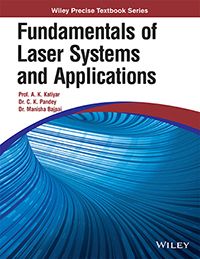Fundamentals of Laser Systems and Applications
ISBN: 9788126568260
244 pages
Publication Year: 2017
eBook also available for institutional users
For more information write to us at: acadmktg@wiley.com

Description
This book has been written to serve as a text for revised syllabus of Laser System and Applications of Dr. APJ Abdul Kalam Technical University (AKTU), Lucknow and other universities where such types of courses are running. The requirements of the students have been fulfilled by explaining the basic principles of laser action, components of laser, various systems involved in lasers and types of lasers with characteristics and applications of lasers in a simple and systematic manner. Sufficient exercises provided at the end of each chapter give this book an edge over other conventional texts.
Preface
Unit I Basic Principle of Modern Physics
Chapter 1 Basic Principles of Modern Physics
1.1 Introduction
1.2 Blackbody Radiation
1.3 Photoelectric Effect
1.4 Compton Effect
1.5 Kinetic Energy of Recoil Electron
1.6 Energy of Scattered X-Ray Photon
1.7 Wave-Particle Duality
1.8 Atomic Structure
1.9 Spectral Series of Hydrogen Atom: Bohr’s Explanation of the Spectrum of the Atomic Hydrogen
1.10 Polarization, Absorption, and Fluorescence of X-Rays
1.11 Energy Distribution in Electrons
1.12 Probability of Distribution of Free Electrons
1.13 Free Electron in Metals
1.14 Energy Levels in Free Electrons
Chapter 2 Applications of Schrödinger Equation
2.1 Introduction
2.2 Time-Independent Schrödinger Wave Equation
2.3 Time-Dependent Schrödinger Wave Equation
2.4 Physical Interpretation of Wave Function y
2.5 Applications of Schrödinger Wave Equations
Unit II Elements and Techniques of Lasers
Chapter 3 Elements and Techniques of Laser
3.1 Introduction
3.2 Concept of Coherence
3.3 Interaction of Radiation with Matter
3.4 Einstein’s Coefficients
3.5 Relation between Einstein’s A and B Coefficients
3.6 Characteristics of Laser Beam
3.7 Components of Laser
3.8 Laser Gain
3.9 Optical Cavity or Optical Resonator
3.10 Quality Factor in Cavities
Unit III Principle of Lasers and General Lasers
Chapter 4 Principle of Lasers and General Lasers
4.1 Introduction
4.2 Main Components of Laser
4.3 Principle of Laser Action
4.4 Introduction to General Lasers and Their Types
4.5 Various Levels of Laser Systems
4.6 Output of Laser Beam
4.7 Short Pulse Generation: Q-Switching and Mode-Locking
4.8 Mode-Locking in Lasers
4.9 Measurement of Laser Radiation Pulses
Unit IV Types of Laser Systems
Chapter 5 Solid-State Lasers
5.1 Introduction
5.2 Ruby Laser
5.3 Neodymium Lasers
5.4 Alexandrite Laser
Chapter 6 Liquid or Dye Lasers
6.1 Introduction
6.2 Liquid Laser
6.3 Dye Laser
6.4 Tuning in Dye Lasers
6.5 Types of Dye Lasers
Chapter 7 Semiconductor or Diode Lasers
7.1 Introduction
7.2 Some Basics of Semiconductors
7.3 Types of Semiconductors
7.4 Principle of Semiconductor or Diode Lasers
7.5 Construction
7.6 Working
7.7 Advantages of Semiconductor or Diode Laser
7.8 Drawbacks of Semiconductor or Diode Laser
7.9 Applications of Semiconductor or Diode Laser
7.10 Types of Semiconductor Lasers
7.11 Quantum-Well Lasers
Chapter 8 Gas Lasers
8.1 Introduction
8.2 Atomic Lasers
8.3 Ionic Lasers
8.4 Molecular Lasers
8.5 Metal Vapor Lasers
Unit V Applications of Lasers
Chapter 9 Laser Applications
9.1 Introduction
9.2 Material Processing with Lasers
9.3 Laser Applications in Medical and Surgery
9.4 Laser Applications in Optical Communication
9.5 Hologram and Their Characteristics
9.6 LIDAR
Types of Laser Systems
Model Test Papers
Index

